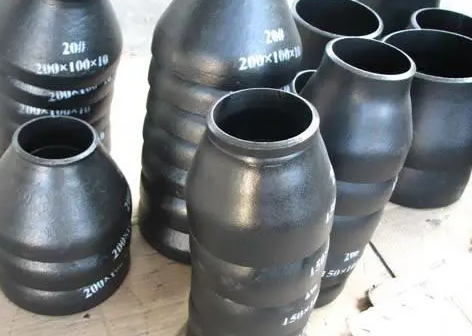What is a pipe reducer?
Pipe reducers are also called reducing straight-through, reducing short pipes, and are commonly known as steel butt welding large and small heads. They are a type of steel butt welding pipe fittings. They are used to connect two different diameter pipes. The role of transition between caliber pipe welds. It is divided into two categories: concentric large and small heads and eccentric large and small heads.

How many types of steel pipe reducers are there? What are the process differences?
Classification of pipe reducer shapes:
(1) Concentric large and small heads. The large and small heads with the center of the circle on a straight line are called concentric large and small heads.
(2) Eccentric large and small heads refer to the large and small heads where the center of the circle is not on the same straight line. Its function is to run pipelines against the wall or the floor without taking up space, and to connect two pipes of different diameters to change the flow rate.
(3) Clamp-type large and small heads are mostly used to quickly connect the large and small heads with clamps, and are suitable for medium and low-pressure fire-fighting water conservancy pipelines.
(4) The size of the thread (thread) is divided into three types: internal and external threads, or internal and external threads.
(5) Socket-type heads: generally forged or forged high-pressure thick-walled heads.
(6) Grooved large and small heads: mostly used for grooved connection of reducers for fire protection pipelines.
How to make a pipe reducer?
The pipe reducer (large and small heads) is a pipe fitting used at the pipe diameter reduction point. The commonly used forming processes are mainly diameter reduction pressing, diameter expansion pressing, or diameter reduction plus diameter expansion pressing. For certain specifications of reducers, stamping can also be used.
1. Diameter reduction/diameter expansion forming
The reduction forming process of the reducer is to put a tube blank with the same diameter as the large end of the reducer into the forming mold, and by pressing the tube blank along the axial direction, the metal moves along the mold cavity and shrinks to form. According to the size of the reducer, it is divided into one-time press forming or multiple press forming.
Diameter expansion forming is to use a tube blank that is smaller than the diameter of the large end of the reducer, and use an inner punch to expand the diameter along the inner diameter of the tube blank. The diameter expansion process mainly solves the problem that the reducer with a larger diameter cannot be easily formed by diameter reduction. Sometimes, the diameter expansion and diameter reduction methods are combined according to the material and product forming needs.
During the deformation and pressing process of diameter reduction or expansion, cold pressing or hot pressing is determined according to different materials and diameter reduction conditions. Under normal circumstances, cold pressing should be used as much as possible, but hot pressing should be used when multiple diameter changes cause severe work hardening, when the wall thickness is too thick, or when alloy steel materials are used.
2. Stamping forming
In addition to using steel pipes as raw materials to produce reducers, some specifications of reducers can also be produced using steel plates using the stamping forming process. The shape of the punch used for drawing is designed with reference to the inner surface dimensions of the reducer, and the punch is used to punch and stretch the blanked steel plate into shape.
Other:
3. Steel plate rolling and forming
After using the steel plate for fan-shaped blanking, the large and small heads are rolled into large and small heads, and then butt welded. This process is mostly suitable for the production of large-diameter reducers, such as 1 meter to 6 meters in diameter. head.
4. High pressure forging large and small heads
Forged small and large heads are integrated reducers forged directly from round steel and steel ingots. Generally, socket pipe fittings and alloy high-pressure small and large heads are suitable for this process. This type of reducer is mostly used in high-pressure pipelines that require high wall thickness, pressure and sealing performance, such as steam pipelines,
boiler pipes, nuclear power pipelines, etc.
Pipe reducer material and standard:
Carbon steel
reducer material: 10#, 20#, A3, Q235B, 20G, 16Mn,
ASTM A234, ASTM A105, Q345B, etc.
Stainless steel reducer material: ASTM A403, 1Cr18Ni9Ti, 0Cr18Ni9, 00Cr19Ni10, 00Cr17Ni14Mo2, 304, 304L, 316, 316L, 321, 310S, F5, etc.
Alloy steel
reducer materials: 16MnR, Cr5Mo, 12Cr1MoV, 10CrMo910, 15CrMo, 12Cr2Mo1, A335P22, St45.8/Ⅲ, A10bB, Q245R, Q345R, 20G, etc.
The roundness of the reducer should not be greater than 1% of the outer diameter of the corresponding end, and the allowable deviation is ±3mm. The material of the reducer shall comply with SY/T5037, GB/T9711, GB/T8163, American standard
ASTM A106/
ASTM A53 GR.B, API 5L, APT5CT, ASTM A105, ASTM A234, ASTM A106, DIN German standards and customer requirements.


